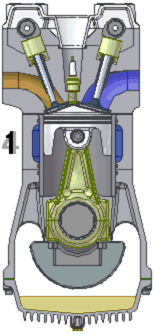Camshaft
From Wikipedia, the free encyclopedia

The camshaft is an apparatus often used in piston engines to operate poppet valves. It consists of a cylindrical rod running the length of the cylinder bank with a number of oblong lobes or cams protruding from it, one for each valve. The cams force the valves open by pressing on the valve, or on some intermediate mechanism, as they rotate.
A camshaft
TimingThe relationship between the rotation of the camshaft and the rotation of the crankshaft is of critical importance. Since the valves control the flow of air/fuel mixture intake and exhaust gases, they must be opened and closed at the appropriate time during the stroke of the piston. For this reason, the camshaft is connected to the crankshaft either directly, via a gear mechanism, or indirectly via a belt or chain called a timing belt or timing chain. In some designs the camshaft also drives the distributor and the oil and fuel pumps. Also on early fuel injection systems, cams on the camshaft would operate the fuel injectors.
In a two-stroke engine that uses a camshaft, each valve is opened once for each rotation of the crankshaft; in these engines, the camshaft rotates at the same rate as the crankshaft. In a four-stroke engine, the valves are opened only half as often; thus, two full rotations of the crankshaft occur for each rotation of the camshaft.
DurationDuration can often be confusing because manufacturers may select any lift point to advertise a camshaft's duration and sometimes will manipulate these numbers. The power and idle characteristics of a camshaft rated at .006" will be much different than one rated the same at .002". Whenever duration is quoted, be sure to note the lift at which it is given.
Many performance engine builders have learned to gauge a race profile's aggressiveness by looking at the duration at .020", .050" and .200". The .020" number determines how responsive the motor will be and how much low end torque the motor will make. The .050" number is used to estimate where peak power will occur, and the .200" number gives an estimate of the power potential.
In general, duration determines how many crankshaft degrees a camshaft maintains more than a given tappet lift.
Camshaft positionDepending on the location of the camshaft, the cams operate the valves either directly or through a linkage of pushrods and rockers. Direct operation involves a simpler mechanism and leads to fewer failures, but requires the camshaft to be positioned at the top of the cylinders. In the past when engines were not as reliable as today this was seen as too much bother, but in modern gasoline engines the overhead cam system, where the camshaft is on top of the cylinder head, is quite common. Some engines use two camshafts each for the intake and exhaust valves; such an arrangement is known as a double or dual overhead cam (DOHC), thus, a V engine may have four camshafts.
MaintenanceThe rockers or cam followers sometimes incorporate a mechanism to adjust and set the valve play through manual adjustment, but most modern auto engines have hydraulic lifters, eliminating the need to adjust the valve lash at regular intervals as the valvetrain wears, and in particular the valves and valve seats in the combustion chamber.
Sliding friction between the surface of the cam and the cam follower which rides upon it is considerable. In order to reduce wear at this point, the cam and follower are both surface hardened, and modern lubricant motor oils contain additives specifically to reduce sliding friction. The lobes of the camshaft are usually slightly tapered, causing the cam followers or valve lifters to rotate slightly with each depression, and helping to distribute wear on the parts. The surfaces of the cam and follower are designed to "wear in" together, and therefore when either is replaced, the other should be as well to prevent excessive rapid wear. In some engines, the flat contact surfaces are replaced with rollers, which eliminate the sliding friction and wear but adds mass to the valvetrain.

Double overhead cams control the opening and closing of a cylinder's valves.


A camshaft


